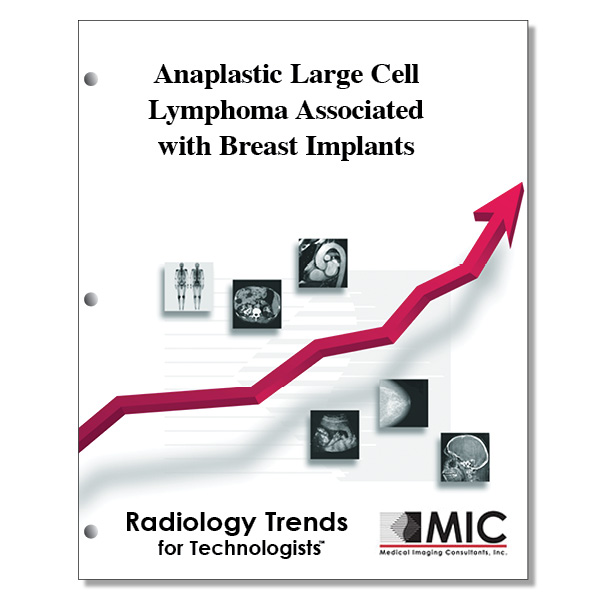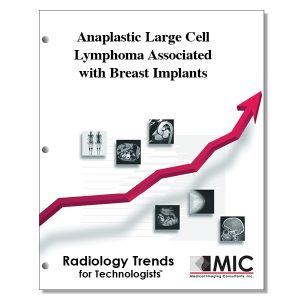

Anaplastic Large Cell Lymphoma Associated with Breast Implants
A look at the rising incidence of breast implant-associated anaplastic large cell lymphoma while detailing key indications, strengths, and limitations of the available imaging techniques.
Course ID: Q00634 Category: Radiology Trends for Technologists Modalities: CT, Mammography, MRI, Nuclear Medicine, PET, Radiation Therapy, Sonography3.0 |
Satisfaction Guarantee |
$34.00
- Targeted CE
- Outline
- Objectives
Targeted CE per ARRT’s Discipline, Category, and Subcategory classification:
[Note: Discipline-specific Targeted CE credits may be less than the total Category A credits approved for this course.]
Breast Sonography: 1.00
Procedures: 1.00
Pathology: 1.00
Computed Tomography: 0.25
Procedures: 0.25
Neck and Chest: 0.25
Mammography: 1.25
Procedures: 1.25
Anatomy, Physiology, and Pathology: 1.25
Magnetic Resonance Imaging: 0.50
Procedures: 0.50
Body: 0.50
Nuclear Medicine Technology: 0.50
Procedures: 0.50
Endocrine and Oncology Procedures: 0.50
Registered Radiologist Assistant: 2.00
Procedures: 2.00
Thoracic Section: 2.00
Sonography: 1.00
Procedures: 1.00
Superficial Structures and Other Sonographic Procedures: 1.00
Radiation Therapy: 2.25
Procedures: 2.25
Treatment Sites and Tumors: 1.00
Treatments: 1.25
Outline
- Introduction
- Definition
- History
- Epidemiology
- Etiology and Pathophysiology
- Clinical Features
- Differential Diagnosis
- Histologic Features
- Radiologic Features
- Ultrasonography
- Mammography
- Computed Tomography
- MR Imaging
- Positron Emission Tomography
- Diagnosis
- Initial Assessment
- Perioperative Workup
- Staging
- Response Assessment
- Treatment
- Surgical Therapy
- Systemic Therapy
- Breast Reconstruction
- Prognosis
- Surveillance
- Future Directions
- Whole-Body DWI
- Novel PET Radiotracers
- Evaluation of Minimal Residual Disease and Circulating DNA
- Conclusion
Objectives
Upon completion of this course, students will:
- know when systemic therapy might be used for BIA-ALCL patients
- be familiar with the various abbreviations used in BIA-ALCL investigations
- know what is critical to optimal management of lymphoma patients
- know the lymphoid neoplasm classification group that BIA-ALCL falls into, according to the World Health Organization
- identify the clinicopathologic subtypes of BIA-ALCL
- know the type of breast implants for which evidence has indicated BIA-ALCL is a complication
- understand why the absolute risk of BIA-ALCL might be higher than the predicted values from recent Dutch and U.S. studies
- be familiar with the various entities to whom new BIA-ALCL cases should be reported
- be familiar with the various hypotheses for patients developing BIA-ALCL
- recognize the factors investigated to determine whether they have an affect on BIA-ALCL risk
- be familiar with the skin lesions with which BIA-ALCL patients most commonly present
- be familiar with BIA-ALCL incidence rates and the factors which affect them
- be familiar with the late seroma differential diagnosis and its common causes in breast implant patients
- understand how to differentiate late seromas from BIA-ALCL
- be familiar with the differential diagnoses for mass-forming BIA-ALCL
- be familiar with the histologic features of BIA-ALCL cells at capsulectomy in patients presenting with effusion around the implant
- know the radiologic imaging techniques that are routinely used in breast radiology and in oncology for implant assessment
- be familiar with the strengths and weaknesses of radiologic techniques in BIA-ALCL
- know the radiologic imaging modality that is the appropriate initial test to evaluate swelling or pain in relation to a breast implant
- recognize how BIA-ALCL mass disease usually manifests at ultrasound
- know conditions that mammography may detect in some BIA-ALCL cases
- know which BIA-ALCL subtypes can be defined at CT
- be familiar with the principle value of CT for BIA-ALCL evaluation
- know the second imaging test of choice for BIA-ALCL diagnosis
- be familiar with the general clinical advantages of PET imaging
- be familiar with Lugano Classification and the Deauville criteria
- recognize the clinically important nuances with PET/CT use for evaluating BIA-ALCL
- know what the initial breast ultrasound screening for BIA-ALCL should assess
- be familiar with the original imaging paradigm for the management of both peri-implant effusion-only and mass-forming subtypes of BIA-ALCL
- know what teams should be involved in a multidisciplinary meeting for BIA-ALCL cases
- be familiar with the proposed TNM staging system from the NCCN consensus guidelines for BIA-ALCL
- describe complete surgical therapy in the peri-implant effusion subtype of BIA-ALCL
- be familiar with the various drugs used in BIA-ALCL systemic therapy
- recognize why patients with more advanced BIA-ALCL should delay reconstruction
- be familiar with the overall survival rates and event-free survival rates for the subtypes of BIA-ALCL
- understand why this paper does not advocate for routine imaging surveillance in BIA-ALCL cases
- be familiar with diffusion-weighted MR imaging and its potential uses
- understand the advantages of whole-body DWI MR for BIA-ALCL
- be familiar with CD30 which may provide a sensitive and specific test for BIA-ALCL staging and response assessment
- be familiar with the goal of elimination of minimal disease to improve cancer outcomes
